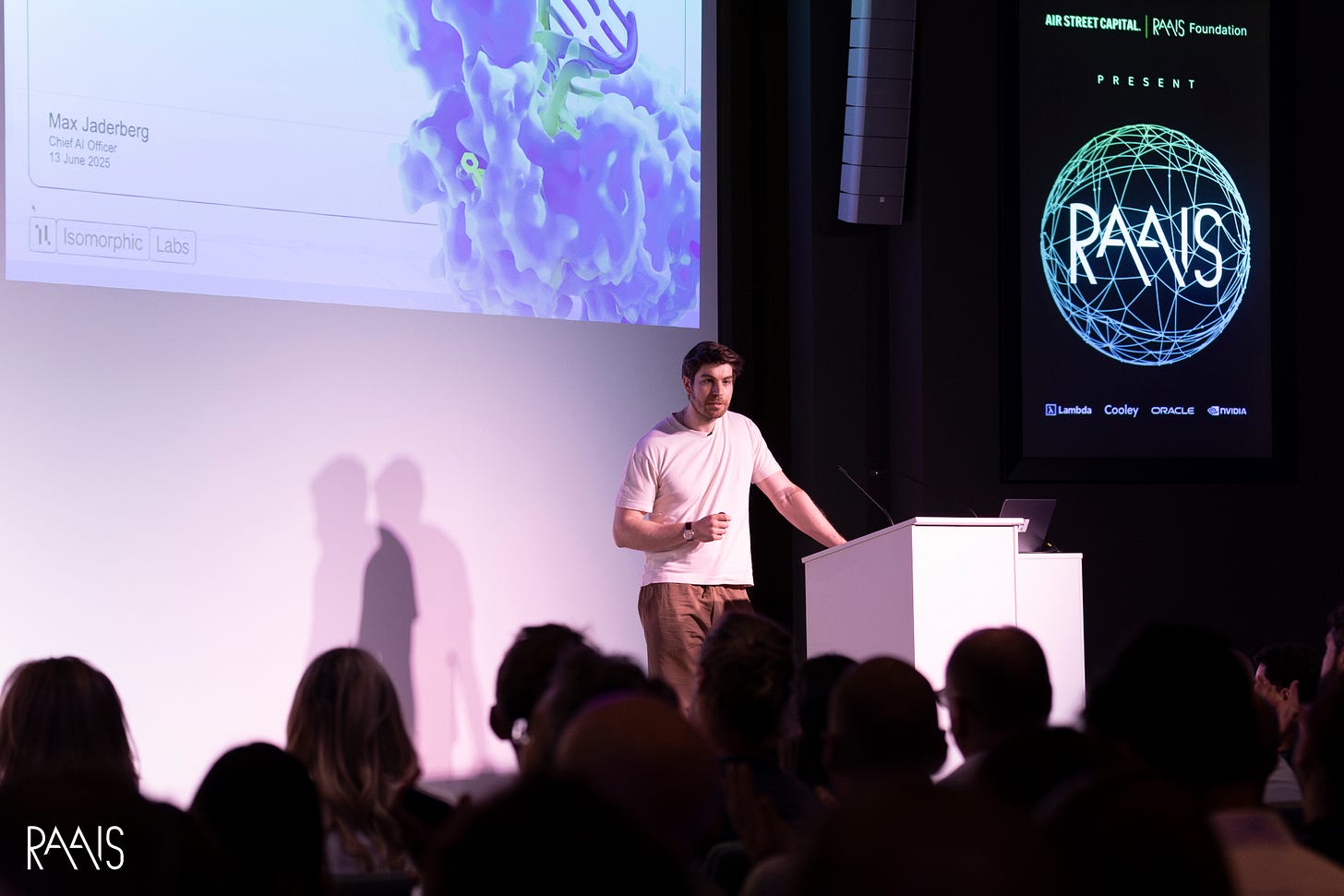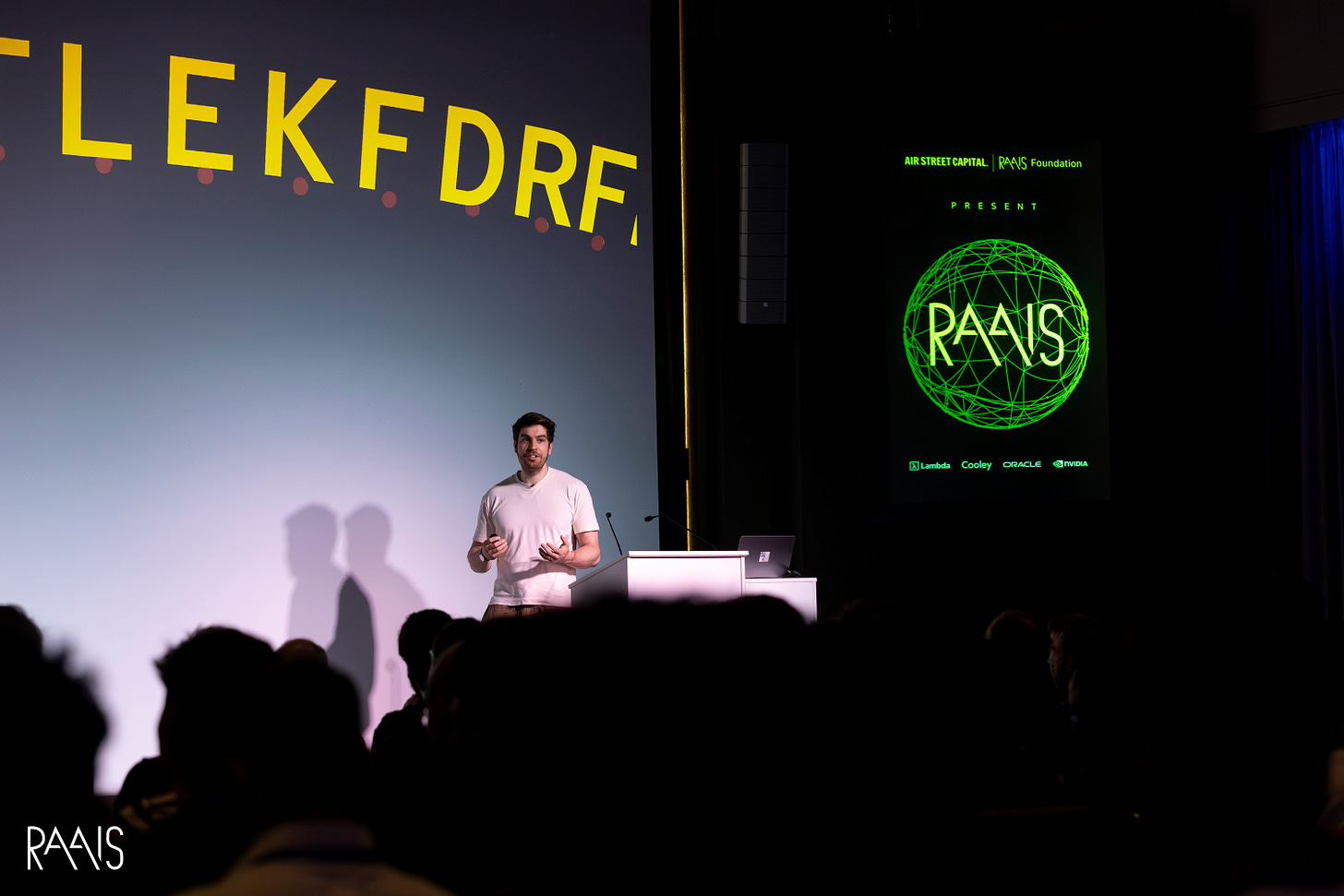From move 37 to drug design
With Max Jaderberg, Chief AI Officer of Isomorphic Labs at RAAIS 2025.
At this year’s RAAIS, Max Jaderberg of Isomorphic Labs delivered a talk that felt like the spiritual sequel to AlphaGo, only this time the board isn’t 19×19, it’s the human body. The stakes? The future of drug discovery and human health.
The audacity of “solving disease”
Isomorphic Labs, the biotech spinout from DeepMind, has declared a radical mission: solving disease. It's not a metaphor. It’s a systems-level wager that the same kinds of models that cracked Go can crack biology. Not only by digitizing wet labs, but by encoding the dynamics of biomolecules into machine-learnable substrates. If AlphaGo marked the start of AI systems inventing strategies never before seen in human play, Isomorphic wants AI to invent medicines we’d never stumble across in the lab.
This is a moonshot, a bet that biology is information science, and machine learning is our best bet at learning its language.
Inspired by games
Jaderberg’s own roots go deep into reinforcement learning (RL). Back at DeepMind, RL was the magic behind AlphaGo’s “move 37", an unexpected yet genius move that shocked the Go world. It wasn’t brute force. It was the AI’s emergent creativity inside a massive search and feedback loop. For Max, it was a formative proof that neural networks could invent, not just interpolate.
Unlike games, however, biology doesn’t offer perfect simulators. The world is slow, stochastic, hard to manipulate, and expensive to probe. If Go was the proving ground, biology is the ultimate generalization test. In both domains, the goal is the same: build a world model that supports reasoning and invention. But in biology, the board is invisible.
Reversing Eroom’s Law
Drug development is stuck in a cruel inverse of Moore’s Law called Eroom’s Law, which describes how R&D spend grows while output shrinks. It’s not for lack of effort. Biology is just too complicated. A single protein’s function emerges from its structure, which emerges from its atomic sequence, which interacts with other molecules in a soup of dynamics we can’t write equations for.
Meanwhile, compute power is still compounding. And AI models, especially transformers, have shown that with enough data and clever architecture, you can reverse the entropy of complexity. Isomorphic Labs is staking its future on this arbitrage: replace trial-and-error with in silico reasoning, and unlock order from the mess.
From AlphaFold to AlphaFold 3: simulating the interactome
Everyone in biotech has heard of AlphaFold 2, DeepMind’s 2021 breakthrough that predicted protein structures from sequences with near-experimental accuracy. But proteins don’t act in isolation. They bind to DNA, RNA, and small molecules. These interactions define function and dysfunction.
Enter AlphaFold 3, Isomorphic’s most important release to date. Jaderberg revealed how the team extended AlphaFold’s neural architecture to simulate multi-molecular interactions. The core innovation is the “PairFormer”: a network that, unlike language transformers which process sequences, reasons over 2D interaction grids between molecules.
This means AlphaFold 3 doesn’t just predict what a protein looks like, it simulates how it behaves when confronted with other actors, like a drug molecule or a strand of DNA.
What makes Isomorphic special
For founders and investors, Jaderberg’s framing of Isomorphic Labs wasn’t just about the models. It was also a study in company design. Unlike many AI-for-biology companies, Isomorphic isn't bolting AI onto biotech. It’s re-architecting the stack from first principles, with model development, inference infrastructure, and biological interpretability all co-designed.
In Jaderberg’s words, AI models are not “tools” for scientists. They are the scientists, reasoning agents embedded in compute. Isomorphic’s goal is to make these agents fluent in biology.
What’s next
With over $600 million raised in its first external funding round, Isomorphic Labs is gearing up for a new chapter. The company is scaling its AI-native drug design platform with clinical ambition: real-world drug trials are on the near horizon. It has inked billion-dollar partnerships with Eli Lilly and Novartis to pursue multi-target discovery across oncology, cardiovascular disease, and neurodegeneration. And with the appointment of Dr. Ben Wolf as Chief Medical Officer and the launch of a U.S. outpost in Cambridge, MA, Isomorphic is assembling the pieces of a full-stack AI-first biotech.
The broader field isn’t standing still either. The next frontier may not be protein folding or drug binding alone, it’s full biological systems modeling. Here, companies like Profluent are taking cues from frontier model scaling and applying them directly to building generative models that output functional proteins from scratch. The race is on not just to simulate biology, but to write it.






